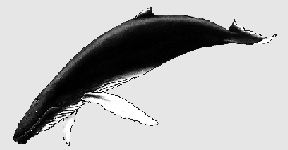
Whales
Kohola / Humpback Whale

Humpback whales are found in tropical to polar nearshore waters. In the northern Pacific, they migrate between Hawai'i (winter) and Alaska (summer), traveling singly, in pairs, or in groups up to 15. Thirty-five to sixty feet long, humpback whales are known for their seemingly playful behavior, waving their long flippers, splashing their tails or leaping from the water. A baleen whale, the humpback feeds on tiny organisms in the water.
Sperm whales range offshore in tropical to subpolar waters around the world. This toothed whale feeds on giant deep-water squid and large fish. Males grow up to 65 feet long, females up to 56 feet. A large head (it has the largest brain of any animal) and a low hump on the back are other physical characteristics. Sperm whales can be identified at a distance by a spout from their blowhole, directed slightly forward and to the left. When they dive for food (up to 10,000 feet down, up to two hours long) their tail fins (flukes) lift from the water. Sperm whales travel in nursery schools of up to 50 females of all ages and immature males. A male school consists of sexually mature males. Mature bulls visit female schools during mating season.
Short-finned Pilot whales are found in offshore warm temperate and tropical waters. They are smaller than sperm whales, growing up to 18-22 feet long, and have rounded, bulbous heads and pronounced dorsal fins. They live in groups of 10-60 individuals and are somtimes seen traveling with dolphins. They feed mainly on squid.